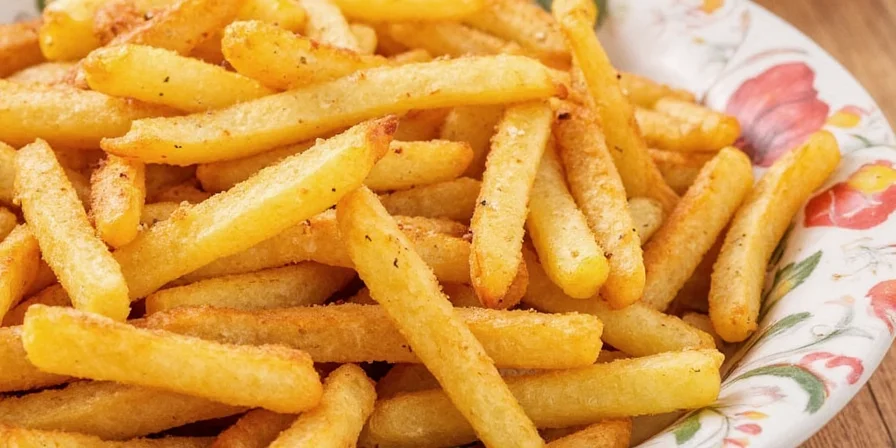For home cooks and food enthusiasts seeking to transform ordinary fries into extraordinary delights, this guide reveals science-backed seasoning techniques that maximize flavor and texture. Discover why salt selection matters, how to create custom blends, and pro solutions for common seasoning pitfalls—no professional kitchen required.
Table of Contents
- Why Salt Matters on Fries: The Science Behind the Crunch
- The Salty Spectrum: Different Types of Salt You Should Try
- Flavor Fusion: How to Make Your Own DIY Seasoned Salt Blends
- Fry Fix-Ups: When Salt Goes Wrong (and How to Save Your Fries)
- Pro Tips: Mastering Timing, Temperature & Tasty Texture
- Conclusion: Level Up Your Fry Experience with the Right Salt

Why Salt Matters on Fries: The Science Behind the Crunch
Salt isn't merely a flavor additive—it triggers critical chemical reactions that define fry quality. When applied to hot fries, salt dissolves in surface moisture and recrystallizes during cooling, forming a microscopic crust that locks in crispness. This process also suppresses bitterness in frying oils while amplifying savory notes through umami pathways.
- Salt's hygroscopic nature draws surface moisture, accelerating evaporation for optimal crunch
- It modulates taste perception by suppressing bitterness in starches and oils
- Fine grains adhere instantly to hot fries; coarse salts require strategic timing

The Salty Spectrum: Different Types of Salt You Should Try
| Salt Type | Texture | Flavor Profile | Best Application Method |
|---|---|---|---|
| Table Salt | Fine | Bold, briny | Shake immediately post-frying for even coating |
| Kosher Salt | Coarse | Clean, pure saltiness | Hand-sprinkle during last 30 seconds of frying |
| Sea Salt Flakes | Crunchy, flaky | Mineral-rich, delicate | Post-cooling garnish for textural contrast |
| Smoked Salt | Varies | Earthy, woodsy | Mix with oil before baking for infusion |
| Celtic Gray Salt | Damp, coarse | Mild, mineral-laced | Combine with vinegar for dipping sauce |

Flavor Fusion: How to Make Your Own DIY Seasoned Salt Blends
Elevate beyond basic salt with precision-engineered blends. Each ratio balances flavor chemistry for maximum impact:
- Parmesan & Herb Salt: 3 parts salt + 1 part finely grated Parmesan + 1 tsp dried thyme + 1 tsp rosemary (activates glutamates for umami boost)
- Garlic Lemon Zest Salt: 4 parts salt + 1 tbsp garlic powder + zest of 1 lemon (citric acid enhances salt perception)
- Smoky Paprika Blend: 5 parts salt + 1 tsp smoked paprika + pinch cayenne (capsaicin amplifies heat perception)
- Everything Bagel Fusion: 2 parts salt + 1 tbsp sesame seeds + 1 tbsp poppy seeds + 1 tsp onion powder + 1 tsp garlic powder
- Lime Chili Salt: 3 parts salt + 1 tsp chili powder + zest of 2 limes (ideal for sweet potato fries)

Fry Fix-Ups: When Salt Goes Wrong (and How to Save Your Fries)
Rescue imperfect seasoning with food science solutions:
- Too Much Salt? Toss with 1 tsp apple cider vinegar—acidity counteracts saltiness perception
- Not Enough Salt? Mist with 0.5% saline solution (1/4 tsp salt per cup water) for instant absorption
- Salt Won't Stick? Apply to fries at 160°F (71°C)—optimal temperature for crystal adhesion
- Pre-Salted Fries Taste Flat? Add 0.1% citric acid powder to restore flavor brightness
- Want More Flavor Without Salt? Use 2% nutritional yeast for savory depth through natural glutamates

Pro Tips: Mastering Timing, Temperature & Tasty Texture
Optimize seasoning through controlled variables:
- Apply salt within 15 seconds of frying—surface temperature must exceed 140°F (60°C) for crystal bonding
- For oven fries: Toss in 1 tsp oil + salt mixture before baking (oil carries flavor compounds into surface crevices)
- Reheating fries? Add 50% less salt than initial application to prevent over-seasoning
- Use oil sprayer with 0.2mm nozzle for micro-droplet adhesion (prevents sogginess)
- Store blends in amber glass jars—blocks UV light that degrades flavor compounds

Conclusion: Level Up Your Fry Experience with the Right Salt
French fry seasoning transcends basic salting—it's a precise interplay of chemistry, timing, and texture. By understanding salt's role in moisture control and flavor enhancement, home cooks can consistently achieve restaurant-quality results. The true secret lies not in complexity, but in applying fundamental food science principles with intentionality.
Whether reviving historical seasoning techniques from mid-20th century diners or innovating with modern blends, remember: perfect fry seasoning balances science with simplicity. Now go transform your next batch with confidence!

Ready to Crisp It Up?
Try the Garlic Lemon Zest blend and tag us in your fry experiments! Share your seasoning breakthroughs below 👇
Frequently Asked Questions
When is the optimal moment to salt fries?
Apply within 15 seconds post-frying while surface temperature exceeds 140°F (60°C). This allows salt crystals to dissolve in surface moisture and recrystallize for perfect adhesion and crispness enhancement.
Can iodized salt affect fry texture?
Yes. Iodized salt contains anti-caking agents that can create a slightly gritty texture. For optimal crispness, use non-iodized salts like sea salt or kosher salt which dissolve more cleanly on hot surfaces.
Why do my oven-baked fries never get as crisp as fried ones?
Oven baking lacks the rapid moisture evaporation of deep frying. Solution: Toss fries in 1 tsp oil per serving with salt before baking. The oil carries salt into surface crevices and creates conductive heat transfer points for better crisping.
How long do homemade seasoned salts last?
Store in airtight amber glass containers away from light. Most blends maintain peak flavor for 3-4 months. Herbal blends degrade faster (2 months) due to volatile oil evaporation—add dried herbs just before use for maximum freshness.











 浙公网安备
33010002000092号
浙公网安备
33010002000092号 浙B2-20120091-4
浙B2-20120091-4